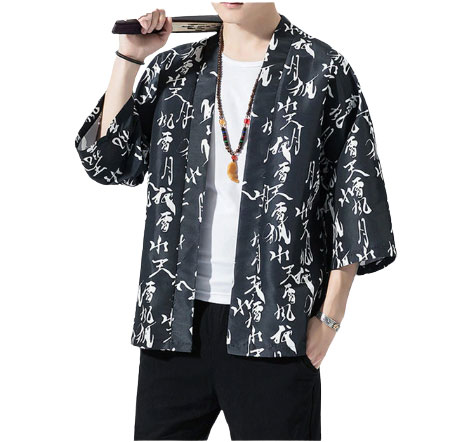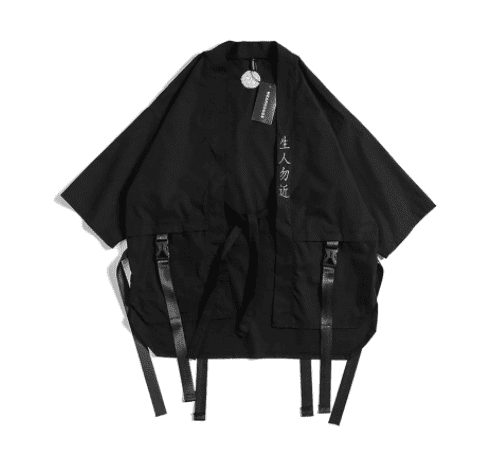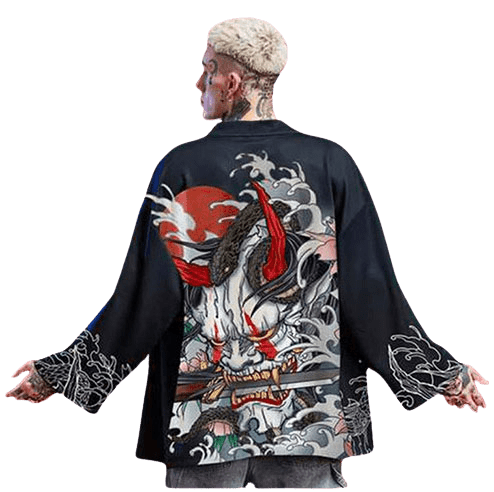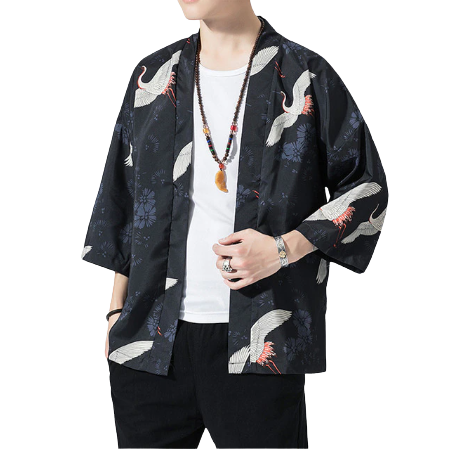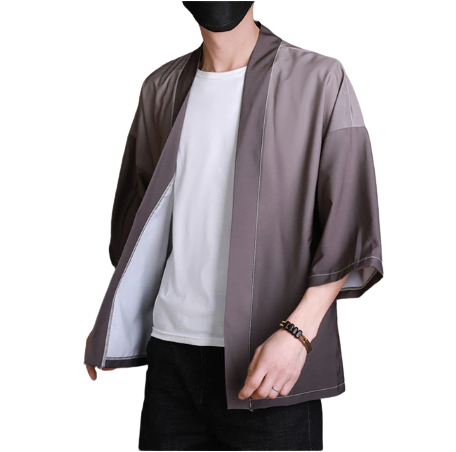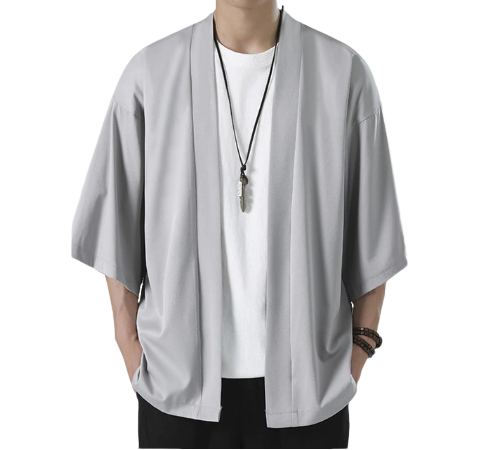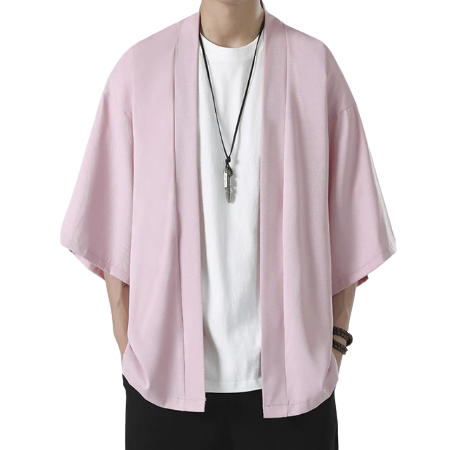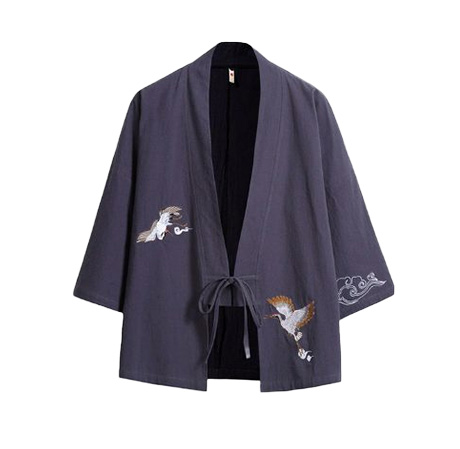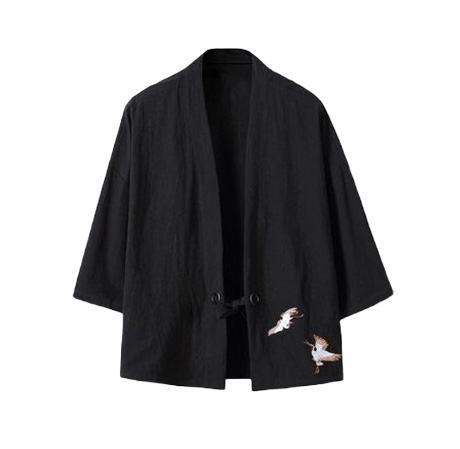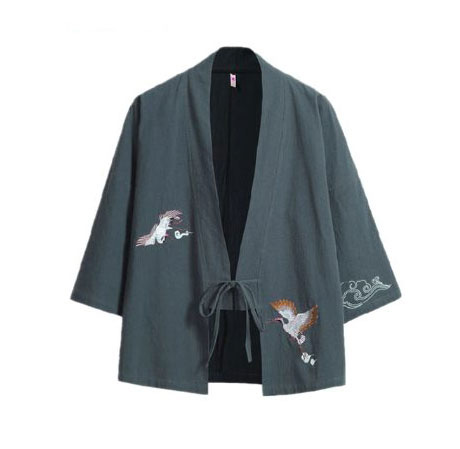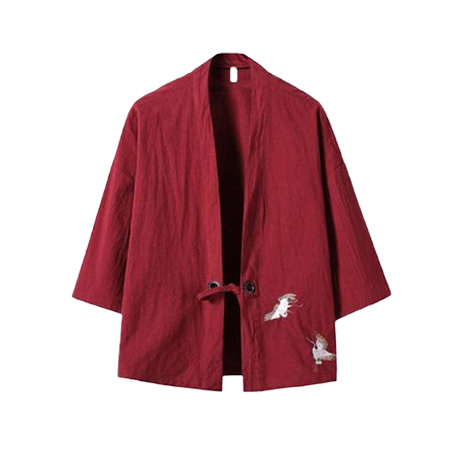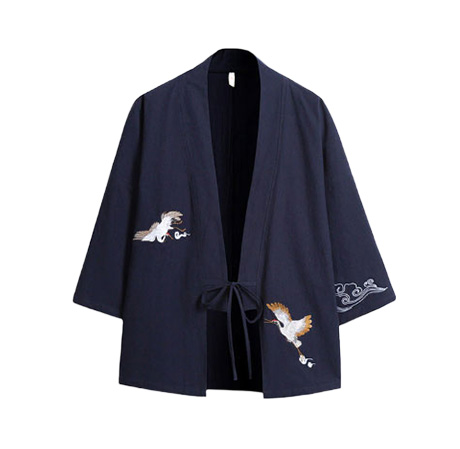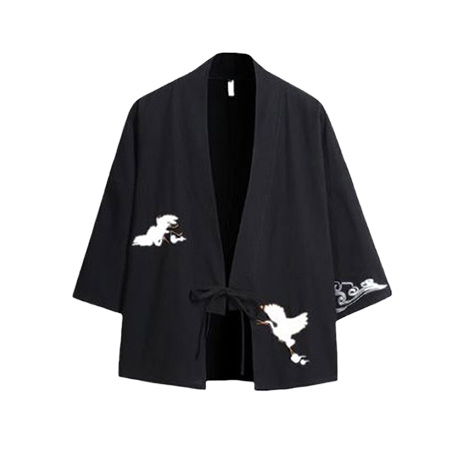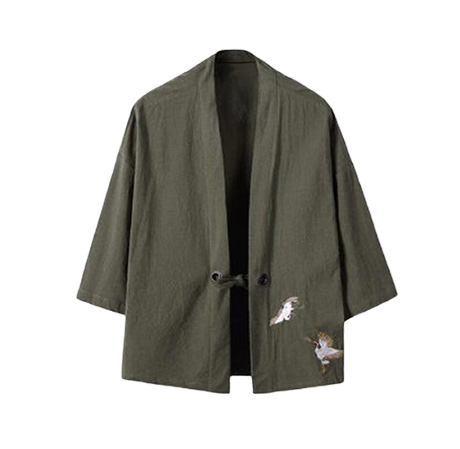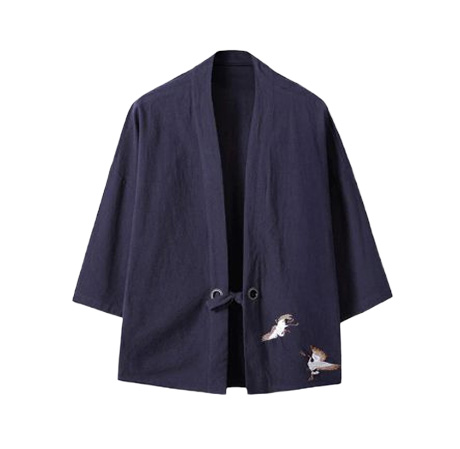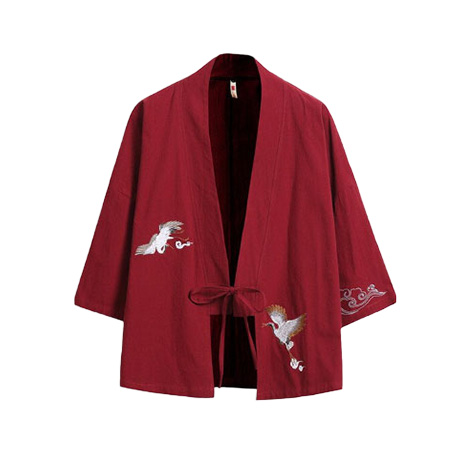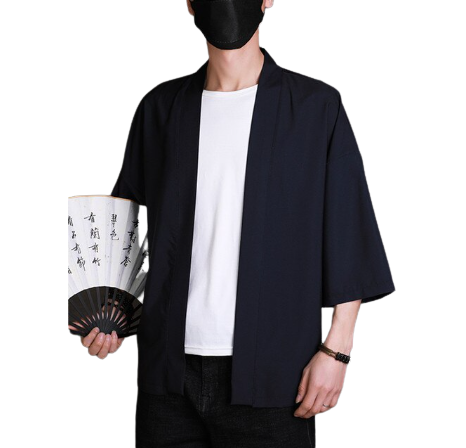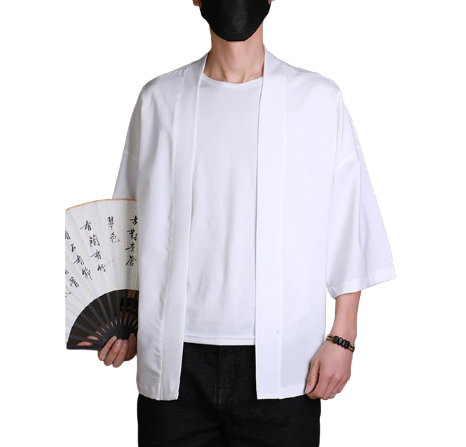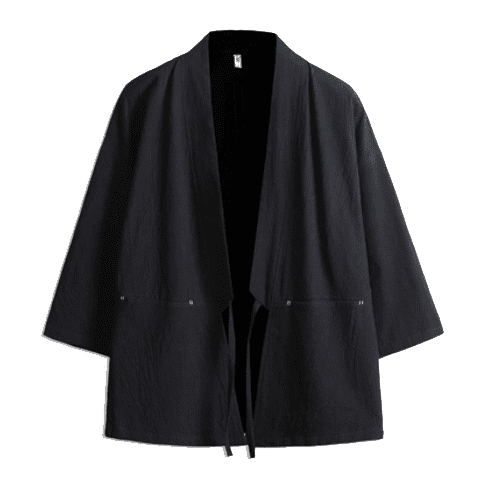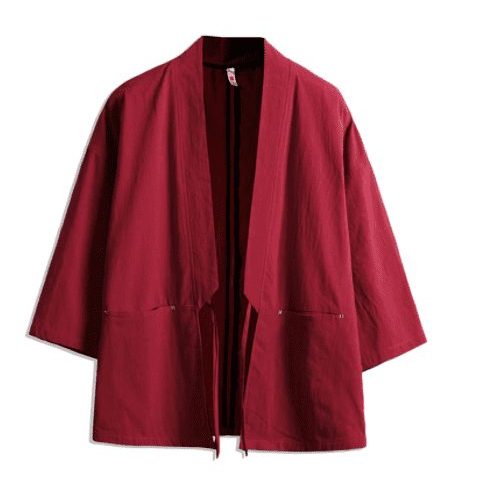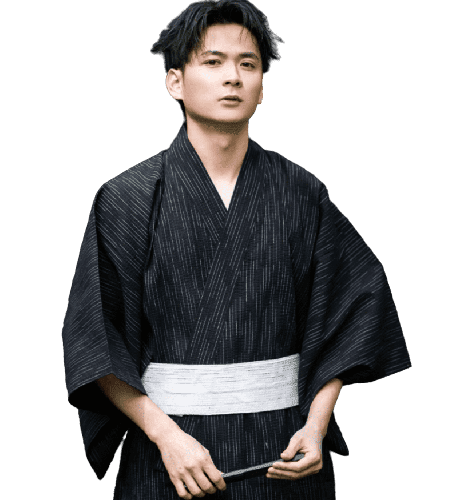Men's Kimono


Filter by price
Average rating
- Rated 5 out of 5 (10)
- Rated 4 out of 5 (8)
- Rated 3 out of 5 (1)
- Japanese Haori
Oni Kimono
Rated 4.00 out of 579,90$Original price was: 79,90$.49,90$Current price is: 49,90$.
The sharing of fashion around the world creates in us a sense of convenience, but also of equality between cultures. Thus, the kimono designed in a unique context of Japanese culture gives rise to new ideas. It inspires more and more fashion designers. What is the kimono in Japanese culture? Discover in this article all you need to know about the kimono for men.
The Kimono in Japanese Culture
The Japanese kimono is a key garment in Japanese fashion, often made of cotton, silk or polyester.
It used to be common in Japan to wear these clothes on a daily basis, but now it is less common to wear them during events such as weddings, celebrations or after a relaxing time in Japanese spas.
Today there are several types of modern kimonos, the styles have evolved in several variations, such as the kimono cardigan, the Japanese jacket or haori or night kimonos, bathrobe.
The kimonos give a large surface that does not necessarily take into account the anatomical configuration of the person who wears it. This surface is precisely the privileged support that expresses the Japanese art. The kimono is undoubtedly one of the best known and most used ancient garments in Japanese culture. Even if dresses and suits mark their presence, the kimono still continues to influence Western designers. This garment is still relevant today.
It was for a long time designed from silk material. The kimono is now available in different materials. However, the Japanese culture would like each kimono pattern to be adapted to each specific event and season. The world today is rather fascinated by this culture which has spread not only in Japan but all over the world.
Still on its evolutionary line from its historical, beyond a traditional garment, the kimono cardigan has become a work of art that fashion followers embrace. The configuration of the Japanese kimono is a source of inspiration for designers as the demand for greater variety continues to grow.
How to wear a Japanese kimono?
Very popular in summer, the Japanese kimono for men seduces more and more people thanks to its casual style, but especially by its comfort due to a thin and breathable fabric. In Japan the kimono is worn all year round, but in the West it is worn in the summer or as soon as the weather returns in the spring. The followers will name this kind of kimono “kimono jacket”.
Indeed this clothing is worn and matched with almost everything in the West! In Japan the kimono cardigan is traditionally worn with wooden sandals on two platforms (yes the famous sandals that we see in mangas or anime!)
Tunics are classic Japanese clothes but people sometimes confuse them with ordinary Chinese silk pajamas. But we must point out that although they look similar, they are completely different.
These tunics are usually made from cotton and polyester, but they are available in additional synthetic fibers such as nylon and spandex.
In Europe we don’t often see this kind of clothing, the kimono is more used for indoor wear because of the comfort and sense of freedom it brings. Outside the home, people living in the West will more commonly wear “Japanese tunics” which are in fact Japanese jackets.
Traditionally and according to its configuration, this garment should always be worn left side over right side. On one hand, this technique allows to hide a weapon and on the other hand, it allows to mark the difference between the living and the dead. For, the dead dress by making a crossing in the opposite direction.
After wearing the clothing, you must hold it in place using an obi. This last called obi helps to mark the difference between groups in society. On the other hand, some people prefer to wear it without obi by leaving it open like a cardigan. The obi is usually tied in the back. In order to wear it, you basically have to pay attention to some rules.
Besides crossing the two sides of the tunic, you have to pay attention to your collar. The collar of your tunic should be positioned in such a way that it highlights the back of your neck. In addition, you must absolutely follow the seasons. Although all countries have seasons, Japan is rather proud of its 4 seasons. Patterns or colors should only be worn for specific reasons.
What is a Japanese Kimono?
The Japanese kimono which means “thing to wear” is an ancestral Japanese garment whose existence dates back to the 7th century. At that time, it was known as an undergarment, pants or skirt under the name in Japanese, “kosode”. It is a T-shaped silk garment without buttons that is fastened to the body with a wide belt called an obi.
The cardigan was worn close to the body underneath other layers of clothing as an undergarment. At that time, it was used to differentiate the social castes of the marital status, because it meets precise standards and differs according to the quality of the fabric and the color. Note that the value of the kimono was very high and only the aristocrat could afford to invest in such refined clothes to show his fortune.
Nevertheless, at that time, Japan was under Chinese influence, which was noticeable by the clothes. It was only in the Heian period between the 8th and 10th centuries that Japanese dress began to move away from the Chinese style of dress to finally give way to an aesthetic, refined style in harmony with the finery.
It is from this moment that this dress has come closer to the meaning that is known today. It has more details and is decorated with ornaments. In this era, the kosode designated the kimono with narrow sleeves. As for the osode, it designated the kimono with long sleeves. Moreover, the wearing of kimono outside and not as an undergarment became more and more important in the Japanese culture.
The term kimono did not appear until the 13th century. Then, from the 15th century, the sleeves of the garment became longer and longer and the obi became the most common style. It is a form that closes from a belt without a buckle and clasp. The knotting style of the obi is an art. The Japanese kimono can be presented in different forms. It can be a short or rather long jacket.
Traditionally, this Japanese tunic is worn with an obi as a closure. This Japanese garment is a kind of hand sewn dress which is specific to the Japanese culture. It is a captivating garment, aesthetically fascinating and shows the elegance of the Japanese culture. It represents one of the flagship garments of Japanese culture.
Different kimonos according to the weather and the seasons
Also, like any garment, there are a variety of men’s kimonos for each season and weather.
The difference between these varieties is mainly marked by the manufacturing material, color, pattern and some details. During the summer, for example, you can opt for the summer kimono. This is a garment usually worn on special occasions such as a ceremony or a wedding for example. This japanese jacket made of silk thanks to its transparency is the source of a feeling of freshness.
Linen or cotton tunics are also very suitable and comfortable classic clothes that you can easily wear to counter the summer heat. Temperatures are lower in the fall and it is time to opt for thicker clothes. For this season, it is recommended to wear woolen tunics. They are more comfortable for walks with friends, outings or visits.
To combat the chill that is in full swing in winter, they are lined. In regions where it snows, a layer of cotton is inserted between the two silk layers of the kimono. Spring is also a season in which you can wear jackets such as haori.
Was the kimono worn by the samurai?
Yes, the kimono was a common garment worn by samurai in medieval Japan. Samurai were a class of warriors from Japan who were responsible for protecting their lords and estates, and they were also known for their strict code of honor, called bushido. This tunic was one of the elements of the uniform of these legendary warriors.
Samurai often wore a black silk kimono, called a kamon, which was decorated with their family crest. This garment was also worn by the women and children of the samurai class, although theirs were usually more colorful and patterned. The kimono is still worn today in Japan, although it is mainly considered a traditional garment and is worn for ceremonies and festivals.

